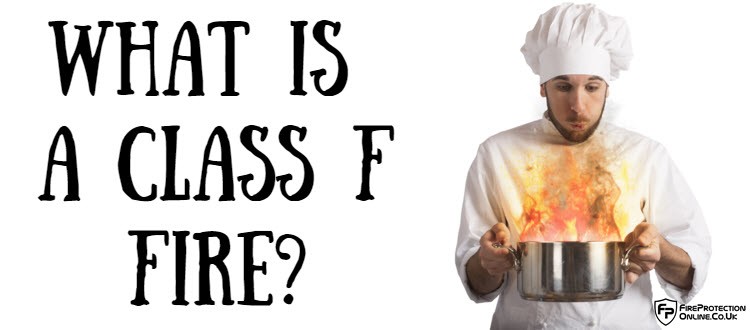
Fire classification systems exist to help people trying to extinguish fires. They allow someone to quickly identify which extinguisher will be best suited to the situation. Fire types are classified according to the fuel which is burning.
This is because different materials don’t burn in the same way. And often, they need an alternative approach to extinguish them.
Understanding the different classifications of fire could save your life and limit the damage caused, especially with a Class F fire.
Class F
Fires involving cooking and vegetable oils or fats are Class F fires, and a wet chemical extinguisher with an F-rating of 75, for example, is suitable for use on deep fat fryers containing up to 75 litres of oil.

These types of fire usually occur in kitchens and will involve dangerous temperatures. They often start when the oil or fat is cooking at an extremely high temperature.
Deep fat frying is the most common cause of a fire.
They are the source of 20% of accidental fires at home that the fire service attend every year. So when using oil and fat to cook in a pan or deep fat fryer, you need to be aware of the potential risks.
Preventing a Class F Fire
The safest way to deep fat fry is to use a thermostatically controlled electric fryer. This is what will stop it from getting to a temperature which will cause it to burn. And if you see smoke, it’s getting too hot so immediately turn off the heat.
You should also take care to not use too much oil or fat, and never fill a pan more than one-third.
And just like any type of cooking, avoid leaving things cooking unattended or get distracted yourself.
Reacting quickly when you can see things are starting to burn will prevent a fire, and save your dinner.
These are same whether you’re cooking at home, or have a large kitchen as part of your business.
You should be doing everything possible to reduce the risks associated with cooking oils and fats.
Tackling a Class F Fire
A Class F fire is different to a Class B fire because of the heat at which it burns. So when it comes to extinguishing a Class F fire, it is appropriate to use a different method.
If you have a business where a Class F is possible, you might consider training your staff in what to do. Whether cooking using gas or electric, you first need to try and turn off the heat source.
When the fire is small, you might be able to use a fire blanket to put it out. Placing one over a fire in its early stages will smother it of oxygen and prevent a bigger fire.
If that isn’t possible, then the only other safe way of extinguishing the fire is a wet chemical extinguisher.
Never throw water over a Class F fire as this cause it to explode, spreading the fire and risking lives.
The best advice is to get to safety using your emergency evacuation plan, then call the fire brigade.
You should never take unnecessary risks with a Class F fire because of how dangerous they can be.